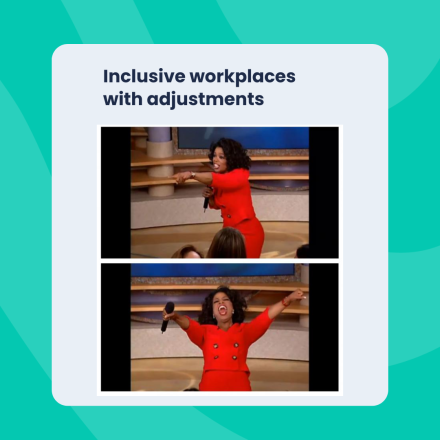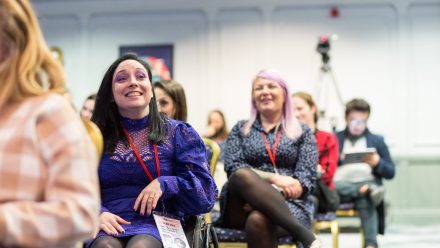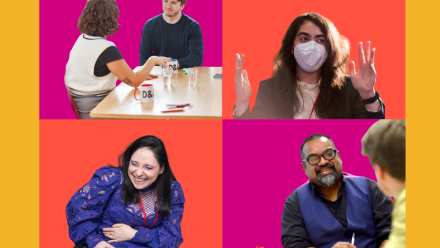7 Workplace Adjustments You Should Make for Everyone
24th October 2024 by Scarlett James
Sans Serif or bust!
Most people know by now that Comic Sans is an accessible font. But we also know it’s ugly. But don’t worry; there are plenty of other accessible options for the Sans Serif family.
Sans Serif fonts are characterised by their lack of those little flicks that Serif fonts have. They’re more accessible because the letters are less likely to appear to blur into each other and because they more closely mimic the flow of handwriting.
You should prioritise legibility and spacing. This means avoiding thin-weight and narrow-width fonts.
The bottom line is that if you aren’t a graphic designer, stick to sans serif. You’ll guarantee everyone can read your text.
Top tip one: Size 12 is a sweet spot for document body text; size 18 is ideal for headings and presentations!
Top tip two: Italics and underlining make text harder to read. Stick to bold, and use headings.
What’s Black and White and read all over? Inaccessible content!
One easy way to check that your content is accessible is to use WCAG-compliant colour contrasts. You can compare two colours with their free contrast checker!
While black text on a white background is WCAG-compliant, it’s not great for our eyes and can cause visual stress. That’s why so many of us use dark modes on our phones and computers!
Switch to a light and dark version of a colour (we use a light and dark blue). Your eyes (and everyone else’s) will thank you.
Closed Captioning – It’s all the rage.
Have you ever been at home thinking, “I can’t hear what they’re saying on my TV!”? Streaming has made dialogue quality poorer because services assume that we all have state-of-the-art surround sound.
This means that many more people are using subtitles, and we’ve discovered that they make life much easier for many of us.
Turning your captioning on as standard in meetings means your neurodiverse and Disabled colleagues don’t even need to ask.
You get a meeting agenda, and you get a meeting agenda and you get …
“Hi Brenda, I’ve just put a 15-minute meeting in your calendar tomorrow at 4.45.”
Everyone feels the fear that comes with that message. Now imagine a world where that didn’t happen.
We’ve got great news: that can be a reality! Whenever you invite people to meetings, ensure there is a clear meeting title and send the agenda in advance. You’ll save everyone from the dread of “Am I getting fired?”.
Did you know that receiving the meeting agenda in advance is the most requested adjustment with AXS Passport? Are you keen to find out those kinds of insights for your organisation? Contact our team to explore how AXS Passport could make adjustments easy breezy.
Splash out and get Spelling and Grammar Software.
So much technology that is now part of our everyday lives began as assistive technology for the Disabled community, including texting and Google Maps!
Spelling and grammar trip most of us up from time to time. While the free spelling and grammar checkers do a decent job, you can feel more confident with the premium versions.
Providing your whole team with premium spelling and grammar checkers can save everyone time and energy on proofreading.
Check out our free assistive technology trials resource to try different spelling and grammar checkers and encourage your team to do the same!
Flexible Working; it’s the law!
The Flexible Working Bill came into effect on April 6th 2024, legally giving employees the right to request flexible working hours from their first day.
Most people benefit from the ability to work flexibly. Whether you need to make that dentist appointment, pick up the kids from school or drop in on an elderly relative- life doesn’t stop for the nine-to-five.
If most of your team is already working in this way, why even make them ask? Provide a flexible working policy that outlines expectations and trust your team to make the right calls.
Build Better, Build Smarter.
Don’t wait for Disabled people to ask to factor accessibility into your physical space design. Creating accessible spaces means that everyone has a better time in the space: yes, Disabled people but also pregnant people; older people; and people who went on a skiing holiday at Christmas and tried a move they shouldn’t have and broke their leg.
Don’t just think of ramps; creating an accessible space should also consider hidden disabilities and neurodiversity.
Need a hand? We’ll do the heavy lifting for you. Check out our Physical Access Audits.
Craving more tips? Our team’s expertise can be yours; explore our services to learn how.



